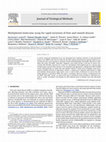Papers by Sharon Messenger

American journal of industrial medicine, 2015
During 2012, a total of 10 overnight visitors to Yosemite National Park (Yosemite) became infecte... more During 2012, a total of 10 overnight visitors to Yosemite National Park (Yosemite) became infected with a hantavirus (Sin Nombre virus [SNV]); three died. SNV infections have been identified among persons with occupational exposure to deer mice (Peromyscus maniculatus). We assessed SNV infection prevalence, work and living environments, mice exposures, and SNV prevention training, knowledge, and practices among workers of two major employers at Yosemite during September-October, 2012 by voluntary blood testing and a questionnaire. One of 526 participants had evidence of previous SNV infection. Participants reported frequently observing rodent infestations at work and home and not always following prescribed safety practices for tasks, including infestation cleanup. Although participants had multiple exposures to deer mice, we did not find evidence of widespread SNV infections. Nevertheless, employees working around deer mice should receive appropriate training and consistently follo...

The American journal of tropical medicine and hygiene, Jan 7, 2015
Chikungunya virus is an emerging threat to the United States because humans are amplifying hosts ... more Chikungunya virus is an emerging threat to the United States because humans are amplifying hosts and competent mosquito vectors are present in many regions of the country. We identified laboratory-confirmed chikungunya virus infections with diagnostic testing performed in the United States from 2010 through 2013. We described the epidemiology of these cases and determined which were reported to ArboNET. From 2010 through 2013, 115 laboratory-confirmed chikungunya virus infections were identified. Among 55 cases with known travel history, 53 (96%) reported travel to Asia and 2 (4%) to Africa. No locally-acquired infections were identified. Six patients had detectable viremia after returning to the United States. Only 21% of identified cases were reported to ArboNET, with a median of 72 days between illness onset and reporting. Given the risk of introduction into the United States, healthcare providers and public health officials should be educated about the recognition, diagnosis, an...
The Pediatric Infectious Disease Journal, 2009
By D7 after a single booster dose, all subjects elicited a rapid increase in RVNA concentrations.... more By D7 after a single booster dose, all subjects elicited a rapid increase in RVNA concentrations. A significant lower response in the ID groups at all time points is in accordance to previous studies with PCECV and PVRV. 5, A recent study in Thailand demonstrated the safety and immunogenicity of 2 or 3 ID doses of PCECV in school children and an anamnestic immune response after 2 simulated PEP booster doses. Studies with other rabies vaccines have reported long term immunity against rabies virus after a pre-exposure series followed by a single booster dose after 1 year. In our study, all children in the half-IM group even had RVNA concentrations Ͼ100 IU/mL on Y1 ϩ 7days. No evidence that either route or dose of concomitant administration of PCECV had an impact on JE antibodies at 1:10 serum dilution was detected.

The Pediatric Infectious Disease Journal, 2013
Pediatric encephalitis is a devastating diagnosis with little guidance regarding prognostic indic... more Pediatric encephalitis is a devastating diagnosis with little guidance regarding prognostic indicators early in the hospitalization. This is a retrospective cohort study of patients with encephalitis referred to the California Encephalitis Project from Children's Hospital & Research Center Oakland from 1998 to 2010. Demographic, clinical, laboratory and neuroimaging data were collected by California Encephalitis Project and chart review. Outcomes were classified into "recovery" or "incomplete recovery" and evaluated at discharge and other times (7-10 days postadmission, 3 and 12 months postdischarge). Using logistic regression, predictors associated with recovery were identified. Of 190 patients with outcomes available at discharge, 128 patients (67.4%) recovered, whereas 62 (32.6%) had an incomplete recovery, including 13 deaths (6.8%). Variables predictive of outcomes at discharge in the bivariate and multivariable analyses included Asian/Pacific Islander race, neuroimaging results and Glasgow Coma Score. Asian/Pacific Islander patients were less likely to recover than patients of other races (adjusted odds ratio = 0.43, P = 0.046). Patients with normal neuroimaging studies were more likely to recover than patients with abnormal neuroimaging (adjusted odds ratio = 2.54, P = 0.008). Patients with Glasgow Coma Score ≥7 were more likely to recover than patients with Glasgow Coma Score <7 (adjusted odds ratio = 5.82, P < 0.001). In a multivariable analysis, similar statistically significant findings were noted at all other analyzed times. Results were similar using a different population for validation, however, due to the small number of Asian/Pacific Islander patients; this finding could not be validated. This study is unique in identification of race/ethnicity as an independent predictor of pediatric encephalitis outcomes. Additional variables may be useful ancillary tools in determining prognosis.

Pediatric Critical Care Medicine, 2011
To identify the respiratory viral pathogens associated with acute lower respiratory tract infecti... more To identify the respiratory viral pathogens associated with acute lower respiratory tract infection in critically ill pediatric patients by using real-time reverse transcription-polymerase chain reaction, and compare results with those of direct fluorescence antibody assay testing. Observational cohort study. Pediatric intensive care unit at a tertiary care academic hospital. Pediatric patients admitted to the pediatric intensive care unit with severe respiratory symptoms consistent with viral lower respiratory tract infection. None. Respiratory samples of pediatric patients admitted to the pediatric intensive care unit with severe respiratory symptoms between January 2008 and July 2009 were tested with direct fluorescence antibody assay and real-time reverse transcription-polymerase chain reaction. At least one viral agent was detected in 70.5% of specimens by real-time reverse transcription-polymerase chain reaction and in 16.5% by direct fluorescence antibody assay (p < .001). Real-time reverse transcription-polymerase chain reaction increased the total viral yield five-fold compared to direct fluorescence antibody assay. Rhinovirus was the most commonly identified virus (41.6%). For viruses included in the direct fluorescence antibody assay panel, direct fluorescence antibody assay had a sensitivity of 0.42 (95% confidence interval 0.25-0.61) and a specificity of 1 (95% confidence interval 0.86-1.00) compared with real-time reverse transcription-polymerase chain reaction. Coinfections were not uncommon, in particular with rhinovirus, and these patients tended to have higher mortality. Direct fluorescence antibody assay testing is a suboptimal method for the detection of respiratory viruses in critically ill children with lower respiratory tract infection. Given the importance of a prompt and accurate viral diagnosis for this group of patients, we suggest that real-time reverse transcription-polymerase chain reaction becomes part of the routine diagnostic algorithm in critically ill children when a viral etiology is suspected, even if conventional tests yield a negative result.
Journal of Clinical Virology, 2009
Unlike its devastating teratogenic effects, post-natal infection with rubella typically causes su... more Unlike its devastating teratogenic effects, post-natal infection with rubella typically causes subclinical or inapparent illness. While rubella has been largely eliminated from the United States following the introduction of an efficacious live-attenuated vaccine in 1969, a small proportion of the population remains susceptible. Recent declining vaccination rates have resulted in a rising incidence of sporadic and outbreak-associated measles, reminding us that an increasing proportion of the population is also susceptible to, and may be reservoirs of transmission for, rubella. We describe two rare adult cases with no clear exposure. These cases serve as a reminder that clinicians should remain vigilant and consider rubella infection in susceptible patients, including older adults, presenting with febrile rash illness.
Described are kits and methods useful for detection of seven agricultural pathogens (BPSV; BHV; B... more Described are kits and methods useful for detection of seven agricultural pathogens (BPSV; BHV; BVD; FMDV; BTV; SVD; and VESV) in a sample. Genomic sequence information from 7 agricultural pathogens was analyzed to identify signature sequences, e.g., polynucleotide sequences useful for confirming the presence or absence of a pathogen in a sample. Primer and probe sets were designed and optimized

The Lancet. Infectious diseases, Jan 30, 2015
Enterovirus D68 was implicated in a widespread outbreak of severe respiratory illness across the ... more Enterovirus D68 was implicated in a widespread outbreak of severe respiratory illness across the USA in 2014 and has also been reported sporadically in patients with acute flaccid myelitis. We aimed to investigate the association between enterovirus D68 infection and acute flaccid myelitis during the 2014 enterovirus D68 respiratory outbreak in the USA. Patients with acute flaccid myelitis who presented to two hospitals in Colorado and California, USA, between Nov 24, 2013, and Oct 11, 2014, were included in the study. Additional cases identified from Jan 1, 2012, to Oct 4, 2014, via statewide surveillance were provided by the California Department of Public Health. We investigated the cause of these cases by metagenomic next-generation sequencing, viral genome recovery, and enterovirus D68 phylogenetic analysis. We compared patients with acute flaccid myelitis who were positive for enterovirus D68 with those with acute flaccid myelitis but negative for enterovirus D68 using the two...
Journal of clinical microbiology, 2000
Broad-range PCR primers were used to amplify part of the groESL operon of the canine pathogen Ehr... more Broad-range PCR primers were used to amplify part of the groESL operon of the canine pathogen Ehrlichia ewingii, recently recognized as a human pathogen, and the murine pathogen Ehrlichia muris. Phylogenetic analysis supported the relationships among Ehrlichia species previously determined by comparison of 16S rRNA gene sequences. These sequences provide additional PCR targets for species for which few gene sequences have been determined.

Clinical infectious diseases : an official publication of the Infectious Diseases Society of America, Jan 30, 2015
We describe the spectrum of etiologies associated with temporal lobe (TL) encephalitis and ident... more We describe the spectrum of etiologies associated with temporal lobe (TL) encephalitis and identify clinical and radiologic features that distinguish herpes simplex encephalitis (HSE) from its mimics. We reviewed all adult cases of encephalitis with TL abnormalities on magnetic resonance imaging (MRI) from the California Encephalitis Project. We evaluated the association between specific clinical and MRI characteristics and HSE compared with other causes of TL encephalitis and used multivariate logistic modeling to identify radiologic predictors of HSE. Of 251 cases of TL encephalitis, 43% had an infectious etiology compared with 16% with a noninfectious etiology. Of infectious etiologies, herpes simplex virus was the most commonly identified agent (n = 60), followed by tuberculosis (n = 8) and varicella zoster virus (n = 7). Of noninfectious etiologies, more than half (n = 21) were due to autoimmune disease. Patients with HSE were older (56.8 vs 50.2 years; P = .012), more likel...

Proceedings of the Royal Society B: Biological Sciences, 1999
The evolution of virulence was studied in a virus subjected to alternating episodes of vertical a... more The evolution of virulence was studied in a virus subjected to alternating episodes of vertical and horizontal transmission. Bacteriophage f1 was used as the parasite because it establishes a debilitating but non-fatal infection that can be transmitted vertically (from a host to its progeny) as well as horizontally (infection of new hosts). Horizontal transmission was required of all phage at specific intervals, but was prevented otherwise. Each episode of horizontal transmission was followed by an interval of obligate vertical transmission, followed by an interval of obligate horizontal transmission etc. The duration of vertical transmission was eight times longer per episode in one treatment than in the other, thus varying the relative intensity of selection against virulence while maintaining selection for some level of virus production. Viral lines with the higher enforced rate of infectious transmission evolved higher virulence and higher rates of virus production. These results support the trade-off model for the evolution of virulence.

PLoS Neglected Tropical Diseases, 2013
One of the hurdles to understanding the role of viral quasispecies in RNA virus cross-species tra... more One of the hurdles to understanding the role of viral quasispecies in RNA virus cross-species transmission (CST) events is the need to analyze a densely sampled outbreak using deep sequencing in order to measure the amount of mutation occurring on a small time scale. In 2009, the California Department of Public Health reported a dramatic increase (.350%) in the number of gray foxes infected with a rabies virus variant for which striped skunks serve as a reservoir host in Humboldt County. To better understand the evolution of rabies, deep-sequencing was applied to 40 unpassaged rabies virus samples from the Humboldt outbreak. For each sample, approximately 11 kb of the 12 kb genome was amplified and sequenced using the Illumina platform. Average coverage was 17,4486and this allowed characterization of the rabies virus population present in each sample at unprecedented depths. Phylogenetic analysis of the consensus sequence data demonstrated that samples clustered according to date (1995 vs. 2009) and geographic location (northern vs. southern). A single amino acid change in the G protein distinguished a subset of northern foxes from a haplotype present in both foxes and skunks, suggesting this mutation may have played a role in the observed increased transmission among foxes in this region. Deepsequencing data indicated that many genetic changes associated with the CST event occurred prior to 2009 since several nonsynonymous mutations that were present in the consensus sequences of skunk and fox rabies samples obtained from 2003-2010 were present at the sub-consensus level (as rare variants in the viral population) in skunk and fox samples from 1995. These results suggest that analysis of rare variants within a viral population may yield clues to ancestral genomes and identify rare variants that have the potential to be selected for if environment conditions change. Citation: Borucki MK, Chen-Harris H, Lao V, Vanier G, Wadford DA, et al. (2013) Ultra-Deep Sequencing of Intra-host Rabies Virus Populations during Cross-species Transmission. PLoS Negl Trop Dis 7(11): e2555.

Journal of Virological Methods, 2008
A nucleic acid-based multiplexed assay was developed that combines detection of foot-and-mouth di... more A nucleic acid-based multiplexed assay was developed that combines detection of foot-and-mouth disease virus (FMDV) with rule-out assays for two other foreign animal diseases and four domestic animal diseases that cause vesicular or ulcerative lesions indistinguishable from FMDV infection in cattle, sheep and swine. The FMDV "look-alike" diagnostic assay panel contains 5 PCR and 12 reverse transcriptase PCR (RT-PCR) signatures for a total of 17 simultaneous PCR amplifications for 7 diseases plus incorporating 4 internal assay controls. It was developed and optimized to amplify both DNA and RNA viruses simultaneously in a single tube and employs Luminex TM liquid array technology. Assay development including selection of appropriate controls, a comparison of signature performance in single and multiplex testing against target nucleic acids, as well of limits of detection for each of the individual signatures is presented. While this assay is a prototype and by no means a comprehensive test for FMDV "look-alike" viruses, an assay of this type is envisioned to have benefit to a laboratory network in routine surveillance and possibly for post-outbreak proof of freedom from foot-and-mouth disease.
Journal of Virological Methods, 2001
Many diagnostic methods have been used to detect rabies virus antigen. The preferred method for r... more Many diagnostic methods have been used to detect rabies virus antigen. The preferred method for routine diagnosis of rabies in fresh or frozen brain tissues is the fluorescent antibody test (FAT). In this study, the FAT was used to evaluate the rabies status of fresh/frozen brain specimens from more than 800 rabies-suspected cases, in more than 14 different species of animals. A comparable brain specimen from each case was fixed in 10% buffered formalin and examined by the FAT. The evaluation of rabies status between fresh and formalin-fixed tissues was in agreement in more than 99.8% of the cases. When fresh tissue is not available for testing, these results validate the use of this procedure for routine diagnosis of rabies in formalin-fixed brain tissues.
Emerging Infectious Diseases, 2003
Most human rabies deaths in the United States can be attributed to unrecognized exposures to rabi... more Most human rabies deaths in the United States can be attributed to unrecognized exposures to rabies viruses associated with bats, particularly those associated with two infrequently encountered bat species (Lasionycteris noctivagans and Pipistrellus subflavus). These human rabies cases tend to cluster in the southeastern and northwestern United States. In these regions, most rabies deaths associated with bats in nonhuman terrestrial mammals are also associated with virus variants specific to these two bat species rather than more common bat species; outside of these regions, more common bat rabies viruses contribute to most transmissions. The preponderance of rabies deaths connected with the two uncommon L. noctivagans and P. subflavus bat rabies viruses is best explained by their evolution of increased viral infectivity.
Emerging Infectious Diseases, 2008
Emerging Infectious Diseases, 2006
… vol. 153, no. 1, October 1 …, 2007
... Resource Relation, Journal Name: Journal of Virological Methods, vol. 153, no. 1, October 1, ... more ... Resource Relation, Journal Name: Journal of Virological Methods, vol. 153, no. 1, October 1, 2008, pp. 61-69; Journal Volume: 153; Journal Issue: 1. Research Org, Lawrence Livermore National Laboratory (LLNL), Livermore, CA. Sponsoring Org, USDOE. ...
Applied and Environmental Microbiology, 2008



Uploads
Papers by Sharon Messenger